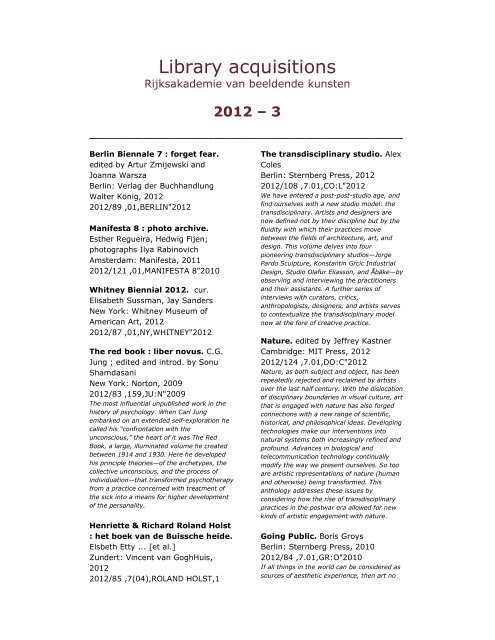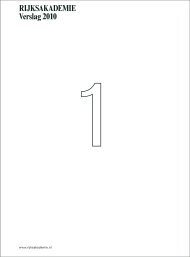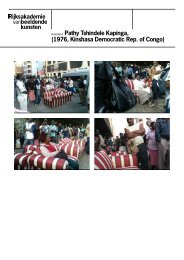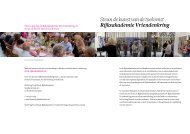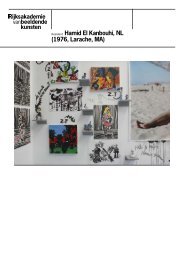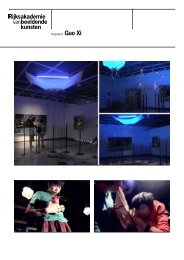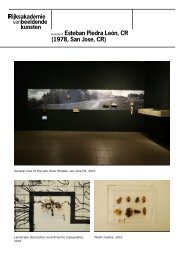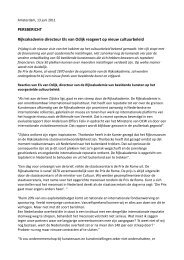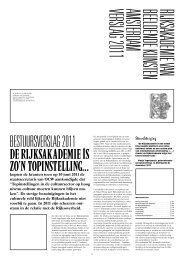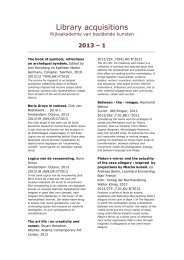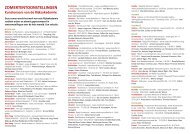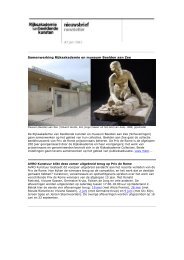library acquisitions 3/2012 - Rijksakademie van beeldende kunsten
library acquisitions 3/2012 - Rijksakademie van beeldende kunsten
library acquisitions 3/2012 - Rijksakademie van beeldende kunsten
Create successful ePaper yourself
Turn your PDF publications into a flip-book with our unique Google optimized e-Paper software.
Library <strong>acquisitions</strong><br />
<strong>Rijksakademie</strong> <strong>van</strong> <strong>beeldende</strong> <strong>kunsten</strong><br />
<strong>2012</strong> – 3<br />
__________________________________________________________<br />
Berlin Biennale 7 : forget fear.<br />
edited by Artur Zmijewski and<br />
Joanna Warsza<br />
Berlin: Verlag der Buchhandlung<br />
Walter König, <strong>2012</strong><br />
<strong>2012</strong>/89 ,01,BERLIN"<strong>2012</strong><br />
Manifesta 8 : photo archive.<br />
Esther Regueira, Hedwig Fijen;<br />
photographs Ilya Rabinovich<br />
Amsterdam: Manifesta, 2011<br />
<strong>2012</strong>/121 ,01,MANIFESTA 8"2010<br />
Whitney Biennial <strong>2012</strong>. cur.<br />
Elisabeth Sussman, Jay Sanders<br />
New York: Whitney Museum of<br />
American Art, <strong>2012</strong><br />
<strong>2012</strong>/87 ,01,NY,WHITNEY"<strong>2012</strong><br />
The red book : liber novus. C.G.<br />
Jung ; edited and introd. by Sonu<br />
Shamdasani<br />
New York: Norton, 2009<br />
<strong>2012</strong>/83 ,159,JU:N"2009<br />
The most influential unpublished work in the<br />
history of psychology. When Carl Jung<br />
embarked on an extended self-exploration he<br />
called his “confrontation with the<br />
unconscious,” the heart of it was The Red<br />
Book, a large, illuminated volume he created<br />
between 1914 and 1930. Here he developed<br />
his principle theories—of the archetypes, the<br />
collective unconscious, and the process of<br />
individuation—that transformed psychotherapy<br />
from a practice concerned with treatment of<br />
the sick into a means for higher development<br />
of the personality.<br />
Henriette & Richard Roland Holst<br />
: het boek <strong>van</strong> de Buissche heide.<br />
Elsbeth Etty ... [et al.]<br />
Zundert: Vincent <strong>van</strong> GoghHuis,<br />
<strong>2012</strong><br />
<strong>2012</strong>/85 ,7(04),ROLAND HOLST,1<br />
The transdisciplinary studio. Alex<br />
Coles<br />
Berlin: Sternberg Press, <strong>2012</strong><br />
<strong>2012</strong>/108 ,7.01,CO:L"<strong>2012</strong><br />
We have entered a post-post-studio age, and<br />
find ourselves with a new studio model: the<br />
transdisciplinary. Artists and designers are<br />
now defined not by their discipline but by the<br />
fluidity with which their practices move<br />
between the fields of architecture, art, and<br />
design. This volume delves into four<br />
pioneering transdisciplinary studios—Jorge<br />
Pardo Sculpture, Konstantin Grcic Industrial<br />
Design, Studio Olafur Eliasson, and Åbäke—by<br />
observing and interviewing the practitioners<br />
and their assistants. A further series of<br />
interviews with curators, critics,<br />
anthropologists, designers, and artists serves<br />
to contextualize the transdisciplinary model<br />
now at the fore of creative practice.<br />
Nature. edited by Jeffrey Kastner<br />
Cambridge: MIT Press, <strong>2012</strong><br />
<strong>2012</strong>/124 ,7.01,DO:C"<strong>2012</strong><br />
Nature, as both subject and object, has been<br />
repeatedly rejected and reclaimed by artists<br />
over the last half century. With the dislocation<br />
of disciplinary boundaries in visual culture, art<br />
that is engaged with nature has also forged<br />
connections with a new range of scientific,<br />
historical, and philosophical ideas. Developing<br />
technologies make our interventions into<br />
natural systems both increasingly refined and<br />
profound. Ad<strong>van</strong>ces in biological and<br />
telecommunication technology continually<br />
modify the way we present ourselves. So too<br />
are artistic representations of nature (human<br />
and otherwise) being transformed. This<br />
anthology addresses these issues by<br />
considering how the rise of transdisciplinary<br />
practices in the postwar era allowed for new<br />
kinds of artistic engagement with nature.<br />
Going Public. Boris Groys<br />
Berlin: Sternberg Press, 2010<br />
<strong>2012</strong>/84 ,7.01,GR:O"2010<br />
If all things in the world can be considered as<br />
sources of aesthetic experience, then art no
longer holds a privileged position. Rather, art<br />
comes between the subject and the world, and<br />
any aesthetic discourse used to legitimize art<br />
must also necessarily serve to undermine it.<br />
Following his recent books Art Power and The<br />
Communist Postscript, in Going Public Boris<br />
Groys looks to escape entrenched aesthetic<br />
and sociological understandings of art—which<br />
always assume the position of the spectator,<br />
of the consumer. Let us instead consider art<br />
from the position of the producer, who does<br />
not ask what it looks like or where it comes<br />
from, but why it exists in the first place.<br />
No order : art in a post-fordist<br />
society. ed. Marco Scotini<br />
Berlin: Archive Books, 2011<br />
<strong>2012</strong>/91 ,7.015,NO:O"2011<br />
This editorial research and investigation<br />
project focuses on the relationships between<br />
contemporary art systems and capitalism’s<br />
production processes. By means of an<br />
investigation into current creative industries—<br />
and their social, economic and semiotic<br />
assemblages—the magazine contributions<br />
(essays, articles, interviews and dialogues as<br />
well as artists’ projects) aim to deconstruct,<br />
analyse and intervene within the ambit of the<br />
procedures and forms of cognitive capitalism.<br />
It will concentrate, in particular, on the<br />
phenomena of the ‘biennalisation’,<br />
‘financialisation’ and ‘spectacularisation’ of the<br />
political, beginning with the control and<br />
distribution of forms of artistic education,<br />
production and display on a global scale.<br />
Diaspora and visual culture :<br />
Representing Africans and Jews.<br />
Edited by Nicholas Mirzoeff<br />
London: Routledge, Taylor&Francis<br />
Group, 2000<br />
<strong>2012</strong>/129 ,7.015.2,MI:R"2000<br />
L.A. Object & David Hammons<br />
body prints. ed. Connie Rogers<br />
Tilton and Lindsay Charlwood; essays<br />
Steve Cannon... [ et al.]<br />
New York: Tilton Gallery, 2011<br />
<strong>2012</strong>/123 ,7.036,AS:S"2011<br />
L.A. Object offers a historical overview of the<br />
Los Angeles assemblage movement of the<br />
1960s and 70s. It focuses on works by<br />
primarily African-American artists often<br />
omitted from mainstream gallery and museum<br />
historical exhibitions who were working during<br />
the civil rights movement, the 1965 Watts<br />
riots and the era's general social and cultural<br />
upheaval.Central to this book are the unique<br />
body prints of David Hammons--ironic, often<br />
political commentaries rele<strong>van</strong>t to the African-<br />
American experience that are presented for<br />
the first time within the context from which<br />
they arose. Also included are photographic<br />
contributions by Bruce Talamon and Harry<br />
Drinkwater.<br />
The studio. edited by Jens<br />
Hoffmann<br />
London: Whitechapel, <strong>2012</strong><br />
<strong>2012</strong>/106 ,7.039,ST:U"<strong>2012</strong><br />
With the emergence of conceptual art in the<br />
mid-1960s, the traditional notion of the studio<br />
became at least partly obsolete. Other sites<br />
emerged for the generation of art, leading to<br />
the idea of "post-studio practice." But the<br />
studio never went away; it was continually<br />
reinvented in response to new realities. This<br />
collection, expanding on current critical<br />
interest in issues of production and situation,<br />
looks at the evolution of studio--and "poststudio"--practice<br />
over the last half century. In<br />
recent decades many artists have turned their<br />
studios into offices from which they organize a<br />
multiplicity of operations and interactions.<br />
Others use the studio as a quasi-exhibition<br />
space, or work on a laptop computer--mobile,<br />
flexible, and ready to follow the next<br />
commission.<br />
Florence & Baghdad :<br />
renaissance art and arab science.<br />
Hans Belting<br />
Cambridge: Belknap Press of Harvard<br />
University Press, 2011<br />
<strong>2012</strong>/122 ,7.049.BE:L"2011<br />
The use of perspective in Renaissance painting<br />
caused a revolution in the history of seeing,<br />
allowing artists to depict the world from a<br />
spectator’s point of view. But the theory of<br />
perspective that changed the course of<br />
Western art originated elsewhere—it was<br />
formulated in Baghdad by the eleventhcentury<br />
mathematician Ibn al Haithan, known<br />
in the West as Alhazen. Using the metaphor of<br />
the mutual gaze, or exchanged glances, Hans<br />
Belting—preeminent historian and theorist of<br />
medieval, Renaissance, and contemporary<br />
art—narrates the historical encounter between<br />
science and art, between Arab Baghdad and<br />
Renaissance Florence, that has had a lasting<br />
effect on the culture of the West.<br />
De hybride <strong>kunsten</strong>aar : de<br />
organisatie <strong>van</strong> de artistieke<br />
praktijk in het postindustriële
tijdperk. Camiel <strong>van</strong> Winkel, Pascal<br />
Gielen, Koos Zwaan<br />
Breda: AKV/St. Joost, <strong>2012</strong><br />
<strong>2012</strong>/126 ,7.07,WI:N"<strong>2012</strong><br />
In dit rapport beschrijven de onderzoekers de<br />
beroepspraktijk <strong>van</strong> drie generaties<br />
afgestudeerden <strong>van</strong> <strong>beeldende</strong><br />
kunstopleidingen in Nederland en Vlaanderen.<br />
Deze praktijk blijkt in toenemende mate in het<br />
teken te staan <strong>van</strong> een hybride vermenging<br />
<strong>van</strong> autonome en toegepaste artistieke<br />
werkzaamheden.<br />
Sweet & salt : water and the<br />
Dutch. Tracy Metz & Maartje <strong>van</strong><br />
den Heuvel<br />
Rotterdam: NAi Publishers, <strong>2012</strong><br />
<strong>2012</strong>/109 ,711 (492),ME:T"<strong>2012</strong><br />
Jean Amado : le doute et la<br />
pierre. Georges Duby...[et al.]<br />
Paris: Musée des Arts Décoratifs,<br />
1985<br />
<strong>2012</strong>/96 ,73,AMADO,4<br />
sens de la mesure : exposition<br />
des travaux de trois jeunes<br />
artistes Européennes résidant à<br />
Melun en automne 1992.<br />
Melun: Conseil Général Seine &<br />
Marne, 1992<br />
<strong>2012</strong>/139 ,73,BEST,1<br />
Judy Chicago : the dinner party :<br />
a symbol of our heritage.<br />
: Anchor Books, 1979<br />
<strong>2012</strong>/90 ,73,CHICAGO,2<br />
Mounir Fatmi : ghosting. Thierry<br />
Raspail... [et al.]<br />
Paris: Studio Fatmi Publishing, 2011<br />
<strong>2012</strong>/111 ,73,FATMI, 4<br />
Mounir Fatmi : fuck the architect.<br />
Paul Ardenne ... [et al.]<br />
Paris: Lowave, 2008<br />
<strong>2012</strong>/110 ,73,FATMI,3<br />
with texts by Paul Ardenne, Naomi Beckwith,<br />
Nicole Brenez, Martina Corgnati, Ariel Kyrou,<br />
Marc Mercier, Pierre-Olivier Rollin, Jérôme<br />
Sans, Evelyne Toussaint and two interviews by<br />
Frédéric Bouglé,<br />
and by Evelyne Toussaint.<br />
This monography also features an interview<br />
with David Hilliard, Black Panthers.<br />
Mounir Fatmi : megalopolis. text<br />
Ali Akay<br />
Istanbul: Akbank Sanat, 2011<br />
<strong>2012</strong>/112 ,73,FATMI,5<br />
Carlos Garaicoa : noticias<br />
recientes. Okwui Enwezor<br />
Burgos: Caja de Burgos, 2011<br />
<strong>2012</strong>/142 ,73,GARAICOA,6<br />
Shilpa Gupta. edited by Nancy<br />
Adajania; texts: Peter Weibel [et al.]<br />
Munich: Prestel, 2009<br />
<strong>2012</strong>/105 ,73,GUPTA,3<br />
Damien Hirst. edited by Ann<br />
Gallagher; with contrib. by MIchael<br />
Craig-Martin ...[et al.]<br />
London: Tate Publishing, <strong>2012</strong><br />
<strong>2012</strong>/118 ,73,HIRST,6<br />
Jan Jonas : works 1968-1994.<br />
Intr. Rudi Fuchs<br />
Amsterdam: Stedelijk Museum, 1994<br />
<strong>2012</strong>/93 ,73,JONAS,9<br />
Sanja Medic : De Reiziger. Sanja<br />
Medic, Gerd Arntz, Dirk <strong>van</strong> Weelden<br />
: , <strong>2012</strong><br />
<strong>2012</strong>/114 ,73,MEDIC,3<br />
De Reiziger: kunsttoepassing op het station<br />
Breukelen 2011<br />
Tine Melzer : time base.<br />
Amsterdam: , 2004<br />
<strong>2012</strong>/138 ,73,MELZER,1<br />
Ron Nagle : sleep study.<br />
Paris: Lefebre & Fils, 2011<br />
<strong>2012</strong>/119 ,73,NAGLE,1<br />
Ron Nagle : odd ball. text Brooke<br />
Mason<br />
Brussels: Pierre Marie Giraud, <strong>2012</strong><br />
<strong>2012</strong>/120 ,73,NAGLE,2
Nils Norman : eetbaar park /<br />
edible park. met bijdragen <strong>van</strong> Nina<br />
Folkersma ... [et al.]<br />
Amsterdam: Valiz, <strong>2012</strong><br />
<strong>2012</strong>/88 ,73,NORMAN,1<br />
Presence : the art of portrait<br />
sculpture. Alexander Sturgis<br />
Woodbridge: Antique Collectors Club,<br />
<strong>2012</strong><br />
<strong>2012</strong>/125 ,73,PO:R"<strong>2012</strong><br />
Iris Le Rütte : beelden en<br />
tekeningen. Martin Reints, T. <strong>van</strong><br />
Deel, Marjoleine de Vos<br />
Amsterdam: , 2003<br />
<strong>2012</strong>/141 ,73,RŐTTE,2<br />
Pak Sheung-chuen : Odd One In<br />
II : Invisible Travel.<br />
Hong Kong: MCCM Creations, 2009<br />
<strong>2012</strong>/128 ,73,SHEUNG-CHUEN,1<br />
Manuel Neri : a sculptor' s<br />
drawings. Jack Cowart, Price<br />
Amerson<br />
Washington: The Corcoran Gallery of<br />
Art, 1994<br />
<strong>2012</strong>/101 ,74,NERI,1<br />
Sandro Setola : Ceci n' est pas<br />
pour rire" (Broodthaers last<br />
words).<br />
<strong>2012</strong>/136 ,74,SETOLA,2<br />
René Daniëls : the words are not<br />
in their proper place. edited by<br />
Roland Groenenboom<br />
Rotterdam: NAi Publishers, <strong>2012</strong><br />
<strong>2012</strong>/95 ,75,DANIELS,12<br />
Florian & Michael Quistrebert :<br />
brothers of the shadow. text<br />
Genesis Breyer P-Orridge<br />
Paris: Galerie Crévecoeur, <strong>2012</strong><br />
<strong>2012</strong>/104 ,75,QUISTREBERT,1<br />
Arthur Kleinjan.<br />
<strong>2012</strong>/134 ,77,KLEINJAN,4<br />
Mimoca' s eye vol.1 : Noguchi<br />
Rika : a feeling of something<br />
happening.<br />
: Marugame Genichiro - Inokuma<br />
Museum of Contemporary Art, 2001<br />
<strong>2012</strong>/132 ,77,NOGUCHI,2<br />
Museutopia : a photographic<br />
research project by Ilya<br />
Rabinovich. ed. Huub <strong>van</strong> Baar and<br />
Ingrid Commandeur<br />
: Alauda Publications, <strong>2012</strong><br />
<strong>2012</strong>/117 ,77,RABINOVICH,2<br />
Rabinovich traveled in 2008 to Chişinău to his<br />
hometown to photograph museum exhibits<br />
and representations in the national museums.<br />
In the process, he encountered an intriguing<br />
development taking shape. Moldova was<br />
incorporated in 1940 by ex-USSR and<br />
remained under Russian Communist rule until<br />
1991. This period is either omitted in the<br />
museum exhibitions or distorted in its<br />
representation: in their own ways, museums<br />
developed their strategy for re-contextualizing<br />
the continual existence of the Moldo<strong>van</strong> state<br />
Anita Di Bianco : ghostwriter.<br />
Maeve Connolly, Katrin Meder,<br />
Stephen Zepke<br />
Braunschweig: Kunstverein<br />
Braunschweig, 2009<br />
<strong>2012</strong>/140 ,78,BIANCO,1<br />
Poor man's expression :<br />
technolgy, experimental film,<br />
conceptual art. edited by Martin<br />
Ebner and Florian Zeyfang<br />
New York: Sternberg, 2011<br />
<strong>2012</strong>/86 ,78,PO:O"2011<br />
Poor Man's Expression examines the<br />
relationship between film, video, technology,<br />
and art, with a particular focus on the<br />
reciprocal influences between conceptual art<br />
and experimental film.<br />
The authors and artists respond to the<br />
questions that arise as to the semantics of<br />
critical and experimental conceptual art,<br />
medial representation, and the expansion of a<br />
concept of technology towards social functions<br />
and psychology; they explore problems of<br />
medial control, intellectual property, and a<br />
changing concept of the public.
Do you feel it too? : the postpostmodern<br />
syndrome in<br />
American fiction at the turn of<br />
the millennium. Nicoline Timmer<br />
Amsterdam: Rodopi, 2010<br />
<strong>2012</strong>/92 ,82,TI:M"2010<br />
Do You Feel It Too? explores a new sense of<br />
self that is becoming manifest in experimental<br />
fiction written by a generation of authors who<br />
can be considered the ‘heirs’ of the<br />
postmodern tradition. It offers a precise, indepth<br />
analysis of a new, post-postmodern<br />
direction in fiction writing, and highlights<br />
which aspects are most acute in the postpostmodern<br />
novel. Most notable is the<br />
emphatic expression of feelings and<br />
sentiments and a drive toward inter-subjective<br />
connection and communication. The self that<br />
is presented in these post-postmodern works<br />
of fiction can best be characterized as<br />
relational. To analyze this new sense of self, a<br />
new interpretational method is introduced that<br />
offers a sophisticated approach to fictional<br />
selves combining the insights of post-classical<br />
narratology and what is called ‘narrative<br />
psychology’.<br />
Pacific standard time : Los<br />
Angeles Art 1945-1980. edited by<br />
Rebecca Peabody, Andrew Perchuk,<br />
Glenn Phillips and Rani Singh<br />
London: Tate Publishing, 2011<br />
<strong>2012</strong>/102 .7.036(73),ST:A"2011<br />
For the first time, Pacific Standard Time : Los<br />
Angeles Art, 1945–1980 documents the<br />
tremendous diversity of Los Angeles’ postwar<br />
art history – a history that is fundamentally<br />
different when told from a West Coast<br />
perspective. Featuring the work of many<br />
world-famous names, including Judy Chicago,<br />
David Hammons, David Hockney, Ed Kienholz<br />
and Ed Ruscha, the book will also introduce<br />
several artists less well known to an audience<br />
outside the U.S., making it an invaluable<br />
resource for years to come


